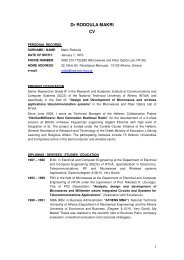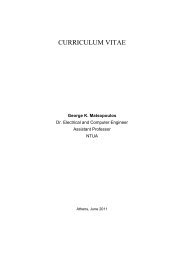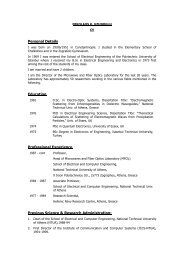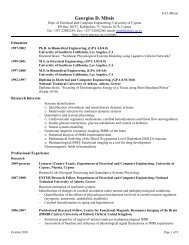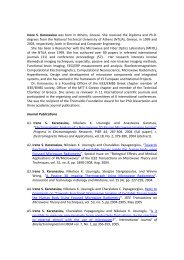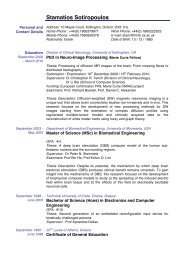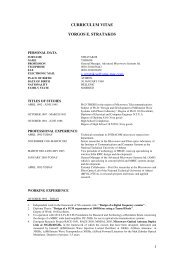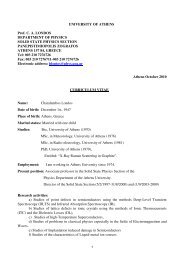The Effect of Silicon Nitride Stoichiometry on Charging Mechanisms ...
The Effect of Silicon Nitride Stoichiometry on Charging Mechanisms ...
The Effect of Silicon Nitride Stoichiometry on Charging Mechanisms ...
You also want an ePaper? Increase the reach of your titles
YUMPU automatically turns print PDFs into web optimized ePapers that Google loves.
3518 IEEE TRANSACTIONS ON MICROWAVE THEORY AND TECHNIQUES, VOL. 57, NO. 12, DECEMBER 2009<br />
<str<strong>on</strong>g>The</str<strong>on</strong>g> <str<strong>on</strong>g>Effect</str<strong>on</strong>g> <str<strong>on</strong>g>of</str<strong>on</strong>g> <str<strong>on</strong>g>Silic<strong>on</strong></str<strong>on</strong>g> <str<strong>on</strong>g>Nitride</str<strong>on</strong>g> <str<strong>on</strong>g>Stoichiometry</str<strong>on</strong>g><br />
<strong>on</strong> <strong>Charging</strong> <strong>Mechanisms</strong> in RF-MEMS<br />
Capacitive Switches<br />
Negar Tavassolian, Student Member, IEEE, M. Koutsoureli, E. Papandreou, Giorgos Papaioannou,<br />
Benjamin Lacroix, Member, IEEE, Z. Liu, and John Papapolymerou, Senior Member, IEEE<br />
Abstract—This paper discusses the mechanisms resp<strong>on</strong>sible for<br />
charging <str<strong>on</strong>g>of</str<strong>on</strong>g> plasma enhanced chemical vapor depositi<strong>on</strong> (PECVD)<br />
silic<strong>on</strong> nitride films used in the fabricati<strong>on</strong> <str<strong>on</strong>g>of</str<strong>on</strong>g> RF microelectromechanical<br />
(MEMS) switches. <str<strong>on</strong>g>Nitride</str<strong>on</strong>g> films deposited at different<br />
temperatures are characterized in order to better understand<br />
the effect <str<strong>on</strong>g>of</str<strong>on</strong>g> depositi<strong>on</strong> c<strong>on</strong>diti<strong>on</strong>s <strong>on</strong> material stoichiometry and<br />
stress. Both RF MEMS switches and metal–semic<strong>on</strong>ductor–metal<br />
capacitors with PECVD silic<strong>on</strong> nitride as the dielectric layer<br />
were fabricated and their charging mechanisms were examined.<br />
Measurements indicate that charging arises from the formati<strong>on</strong><br />
<str<strong>on</strong>g>of</str<strong>on</strong>g> a defect band where charge transport occurs through<br />
a Poole–Frenkel-like effect. <str<strong>on</strong>g>The</str<strong>on</strong>g> calculated activati<strong>on</strong> energy<br />
exhibits direct relati<strong>on</strong> to material stoichiometry, and therefore to<br />
the nitride bandgap. Finally, it is viewed that lower temperature<br />
nitride is less pr<strong>on</strong>e to dielectric charging.<br />
Index Terms—Dielectric materials, metal–semic<strong>on</strong>ductor–metal<br />
(MIM) capacitors, reliability RF microelectromechanical (MEMS)<br />
switches, stoichiometry, stress.<br />
I. INTRODUCTION<br />
CAPACITIVE RF microelectromechanical (MEMS)<br />
switches are am<strong>on</strong>g the most promising applicati<strong>on</strong>s in<br />
MEMS systems, being used especially at higher frequencies<br />
(above 10 GHz). However, their commercializati<strong>on</strong> is currently<br />
hindered by reliability problems. <str<strong>on</strong>g>The</str<strong>on</strong>g> most important problem<br />
is charging <str<strong>on</strong>g>of</str<strong>on</strong>g> the dielectric, causing unpredictable device<br />
behavior [1]–[7]. <str<strong>on</strong>g>The</str<strong>on</strong>g> deposited dielectric films, such as silic<strong>on</strong><br />
nitride, c<strong>on</strong>tain a large density <str<strong>on</strong>g>of</str<strong>on</strong>g> traps associated with dangling<br />
b<strong>on</strong>ds [3], [4]. <str<strong>on</strong>g>The</str<strong>on</strong>g>se traps are amphoteric in nature, so they<br />
can be negatively or positively charged. Under high electric<br />
fields, charges can get injected into the dielectric and become<br />
Manuscript received April 15, 2009; revised April 21, 2009. First published<br />
November 13, 2009; current versi<strong>on</strong> published December 09, 2009. This work<br />
was supported by the IMPACT Center for Advancement <str<strong>on</strong>g>of</str<strong>on</strong>g> MEMS/NEMS<br />
VLSI, funded by DARPA, under Grant HR0011-06-1-0046, under the DARPA<br />
N/MEMS Science and Technology Fundamentals Research Program.<br />
N. Tavassolian, B. Lacroix, Z. Liu, and J. Papapolymerou are with<br />
the School <str<strong>on</strong>g>of</str<strong>on</strong>g> Electrical and Computer Engineering, Georgia Institute <str<strong>on</strong>g>of</str<strong>on</strong>g><br />
Technology, Atlanta, GA 30332-0250 USA (e-mail: negar1@gatech.edu;<br />
blacroix3@mail.gatech.edu; john.papapolymerou@ece.gatech.edu).<br />
G. Papaioannou is with the School <str<strong>on</strong>g>of</str<strong>on</strong>g> Electrical and Computer Engineering,<br />
Georgia Institute <str<strong>on</strong>g>of</str<strong>on</strong>g> Technology, Atlanta, GA 30332-0250 USA, and also with<br />
the Physics Department, Solid State Physics Secti<strong>on</strong>, University <str<strong>on</strong>g>of</str<strong>on</strong>g> Athens,<br />
Athens 15784, Greece (e-mail: gpapaioan@phys.uoa.gr).<br />
M. Koutsoureli and E. Papandreou are with the Physics Department, Solid<br />
State Physics Secti<strong>on</strong>, University <str<strong>on</strong>g>of</str<strong>on</strong>g> Athens, Athens 15784, Greece.<br />
Color versi<strong>on</strong>s <str<strong>on</strong>g>of</str<strong>on</strong>g> <strong>on</strong>e or more <str<strong>on</strong>g>of</str<strong>on</strong>g> the figures in this paper are available <strong>on</strong>line<br />
at http://ieeexplore.ieee.org.<br />
Digital Object Identifier 10.1109/TMTT.2009.2033865<br />
0018-9480/$26.00 © 2009 IEEE<br />
trapped in the b<strong>on</strong>ds. Further, due to the insulating nature <str<strong>on</strong>g>of</str<strong>on</strong>g><br />
the silic<strong>on</strong> oxide or silic<strong>on</strong> nitride films, the recovery time can<br />
take anywhere between a few sec<strong>on</strong>ds to several days or even<br />
m<strong>on</strong>ths.<br />
Developing a good analytical model that would describe accumulating<br />
<str<strong>on</strong>g>of</str<strong>on</strong>g> charges in the dielectric and their influence <strong>on</strong><br />
the device behavior would be the main step to achieving more<br />
reliable switches. Presently, available models assume that dielectric<br />
charging arises from charges distributed throughout the<br />
dielectric material [5], the presence <str<strong>on</strong>g>of</str<strong>on</strong>g> charges at the dielectric<br />
interface [8] and areas under compressive or tensile stress [9],<br />
as well as injecti<strong>on</strong> <str<strong>on</strong>g>of</str<strong>on</strong>g> charges from the suspended bridge during<br />
the <strong>on</strong>-state [10].<br />
So far the effects <str<strong>on</strong>g>of</str<strong>on</strong>g> dielectric charging have been measured<br />
by recording the transient current in permanently ON<br />
switches [11], [12], the transient resp<strong>on</strong>se <str<strong>on</strong>g>of</str<strong>on</strong>g> the ON capacitance<br />
[13], [14], and the correlati<strong>on</strong> <str<strong>on</strong>g>of</str<strong>on</strong>g> Poole–Frenkel (PF)<br />
current intensity to the shift <str<strong>on</strong>g>of</str<strong>on</strong>g> the pull-out voltage [12]. <str<strong>on</strong>g>The</str<strong>on</strong>g><br />
simultaneous study <str<strong>on</strong>g>of</str<strong>on</strong>g> dielectric charging by recording the<br />
capacitance-voltage characteristic in capacitive switches and<br />
the thermally stimulated depolarizati<strong>on</strong> current (TSDC) in<br />
metal–semic<strong>on</strong>ductor–metal (MIM) structures with the same<br />
dielectric has been recently proposed [15]. This method allows<br />
for determinati<strong>on</strong> <str<strong>on</strong>g>of</str<strong>on</strong>g> both the main mechanisms c<strong>on</strong>tributing<br />
to charging <str<strong>on</strong>g>of</str<strong>on</strong>g> the dielectric, which are charge injecti<strong>on</strong> and<br />
dipole orientati<strong>on</strong>. In spite <str<strong>on</strong>g>of</str<strong>on</strong>g> these research efforts, the exact<br />
mechanism <str<strong>on</strong>g>of</str<strong>on</strong>g> charge injecti<strong>on</strong> that is resp<strong>on</strong>sible for dielectric<br />
charging during the switch pull-down state has not yet been<br />
entirely understood.<br />
In thick dielectrics, the main electr<strong>on</strong>ic processes that lead to<br />
dielectric charging are: 1) the trap-assisted-tunneling (TAT) <str<strong>on</strong>g>of</str<strong>on</strong>g><br />
electr<strong>on</strong>s from the electrode to unoccupied defect or trap states<br />
in the dielectric close to the electrode-dielectric interface and 2)<br />
the time-dependent comp<strong>on</strong>ent <str<strong>on</strong>g>of</str<strong>on</strong>g> PF movement <str<strong>on</strong>g>of</str<strong>on</strong>g> the trapped<br />
electr<strong>on</strong>s from the defect levels to the c<strong>on</strong>ducti<strong>on</strong> band <str<strong>on</strong>g>of</str<strong>on</strong>g> the<br />
dielectric [16].<br />
This paper elaborates more <strong>on</strong> the charging mechanisms <str<strong>on</strong>g>of</str<strong>on</strong>g><br />
silic<strong>on</strong> nitride films used in RF MEMS switches in order to identify<br />
the most dominant <strong>on</strong>e. In [17], the authors presented preliminary<br />
results based <strong>on</strong> the the study <str<strong>on</strong>g>of</str<strong>on</strong>g> RF MEMS capacitive<br />
switches with silic<strong>on</strong> nitride deposited at two different temperatures.<br />
<str<strong>on</strong>g>The</str<strong>on</strong>g> charging investigati<strong>on</strong> <str<strong>on</strong>g>of</str<strong>on</strong>g> the switches was based<br />
<strong>on</strong> observing the dependence <str<strong>on</strong>g>of</str<strong>on</strong>g> capacitance-voltage characteristic<br />
<strong>on</strong> both the bias sweep width and temperature. <str<strong>on</strong>g>The</str<strong>on</strong>g> latter<br />
is used to determine the TAT activati<strong>on</strong> energy <str<strong>on</strong>g>of</str<strong>on</strong>g> PF potential
TAVASSOLIAN et al.: EFFECT OF SILICON NITRIDE STOICHIOMETRY ON CHARGING MECHANISMS 3519<br />
barrier in order to understand its relati<strong>on</strong> to the dielectric material<br />
stoichiometry. This paper expands the previously obtained<br />
results by adding more data <strong>on</strong> both RF MEMS switches and<br />
MIM capacitors, and by comparing their charging mechanisms.<br />
<strong>Charging</strong> study <strong>on</strong> the MIM capacitors was d<strong>on</strong>e by applying<br />
the TSDC method. In additi<strong>on</strong>, more detailed informati<strong>on</strong> <strong>on</strong> the<br />
stoichiometry <str<strong>on</strong>g>of</str<strong>on</strong>g> silic<strong>on</strong> nitride films deposited at various temperatures<br />
was obtained using X-ray photoelectr<strong>on</strong> spectroscopy<br />
(XPS) and stress measurements. A relati<strong>on</strong>ship between the depositi<strong>on</strong><br />
temperature and the silic<strong>on</strong> nitride stoichiometry was<br />
derived for the first time. C<strong>on</strong>sistent measurement results provide<br />
a new insight into the charging mechanisms <str<strong>on</strong>g>of</str<strong>on</strong>g> silic<strong>on</strong> nitride<br />
and its dependence <strong>on</strong> the material stoichiometry.<br />
II. THEORETICAL BACKGROUND<br />
A. <strong>Charging</strong> <strong>Mechanisms</strong><br />
In principle, TAT is determined by the spatial and energetic<br />
distributi<strong>on</strong> <str<strong>on</strong>g>of</str<strong>on</strong>g> trap states, the <str<strong>on</strong>g>of</str<strong>on</strong>g>fset between the Fermi energy<br />
<str<strong>on</strong>g>of</str<strong>on</strong>g> the electrode and the c<strong>on</strong>ducti<strong>on</strong> band <str<strong>on</strong>g>of</str<strong>on</strong>g> the dielectric, and<br />
the lower limit <str<strong>on</strong>g>of</str<strong>on</strong>g> the tunneling relaxati<strong>on</strong> times. <str<strong>on</strong>g>The</str<strong>on</strong>g> temperature<br />
dependence <str<strong>on</strong>g>of</str<strong>on</strong>g> TAT is c<strong>on</strong>trolled primarily by the energy<br />
distributi<strong>on</strong> <str<strong>on</strong>g>of</str<strong>on</strong>g> the traps and the frequency dependence is c<strong>on</strong>trolled<br />
by their spatial distributi<strong>on</strong>. Traps distributed uniformly<br />
in both energy and space result in an essentially temperature-independent<br />
mechanism. <str<strong>on</strong>g>The</str<strong>on</strong>g> step-resp<strong>on</strong>se currents for the tunnel<br />
mechanism exhibit an inverse dependence <strong>on</strong> sample thickness<br />
which becomes n<strong>on</strong>linear at high applied electric fields, and the<br />
detailed behavior is very sensitive to the trap distributi<strong>on</strong> assumed.<br />
For a particular trap distributi<strong>on</strong>, it is possible to have a<br />
polarity-dependent irreversible step resp<strong>on</strong>se [13]–[16].<br />
An expressi<strong>on</strong> was derived in [13] and [16] for the timedependent<br />
current, assuming that TAT is the <strong>on</strong>ly operating<br />
mechanism<br />
where the current flows in the directi<strong>on</strong>, is the sample thickness,<br />
is the field-free trap distributi<strong>on</strong>, is the energy,<br />
is the electric field intensity, , and are the Fermi functi<strong>on</strong>s<br />
defined as<br />
and where , , , , and are the electr<strong>on</strong>ic<br />
mass, Planck’s c<strong>on</strong>stant, Boltzmann’s c<strong>on</strong>stant, temperature,<br />
and Fermi energy <str<strong>on</strong>g>of</str<strong>on</strong>g> the metal electrode, respectively.<br />
<str<strong>on</strong>g>The</str<strong>on</strong>g> PF mechanism is driven by the electric field, which reduces<br />
the barrier height <strong>on</strong> <strong>on</strong>e side <str<strong>on</strong>g>of</str<strong>on</strong>g> the trap, thereby increasing<br />
the probability <str<strong>on</strong>g>of</str<strong>on</strong>g> the electr<strong>on</strong> escaping from the trap.<br />
As the electric field increases, the potential barrier decreases <strong>on</strong><br />
(1)<br />
Fig. 1. Typical capacitance-voltage characteristic <str<strong>on</strong>g>of</str<strong>on</strong>g> a capacitive RF MEMS<br />
switch.<br />
the right side <str<strong>on</strong>g>of</str<strong>on</strong>g> the trap, making it easier for the electr<strong>on</strong> to<br />
vacate the trap by thermal emissi<strong>on</strong> and enter the quasi-c<strong>on</strong>ducti<strong>on</strong><br />
band <str<strong>on</strong>g>of</str<strong>on</strong>g> the host material. A first-order model for the current<br />
due to the PF effect assumes that each trapping center is independent<br />
<str<strong>on</strong>g>of</str<strong>on</strong>g> the other centers, i.e., the potentials do not overlap.<br />
This assumpti<strong>on</strong> is valid <strong>on</strong>ly if the impurity density is low. Although<br />
in amorphous materials the impurities density is usually<br />
not very low, this model is generally used for the purpose <str<strong>on</strong>g>of</str<strong>on</strong>g><br />
simplicity. This procedure implicitly assumes just an effective<br />
potential barrier .<br />
<str<strong>on</strong>g>The</str<strong>on</strong>g> transient comp<strong>on</strong>ent <str<strong>on</strong>g>of</str<strong>on</strong>g> PF c<strong>on</strong>ducti<strong>on</strong> was derived in<br />
[13] and [16] assuming that a certain fracti<strong>on</strong> <str<strong>on</strong>g>of</str<strong>on</strong>g> the trapped<br />
electr<strong>on</strong>s are lost to PF emissi<strong>on</strong> (thermal emissi<strong>on</strong> <str<strong>on</strong>g>of</str<strong>on</strong>g> electr<strong>on</strong>s<br />
from the trap states to the c<strong>on</strong>ducti<strong>on</strong> band <str<strong>on</strong>g>of</str<strong>on</strong>g> the dielectric [15]).<br />
<str<strong>on</strong>g>The</str<strong>on</strong>g> PF current density is given by a simple drift equati<strong>on</strong> ,<br />
where , and are the electr<strong>on</strong>ic mobility in the dielectric and<br />
carrier density (per unit area <str<strong>on</strong>g>of</str<strong>on</strong>g> the dielectric) that participate<br />
in the PF process respectively. Since there is a distributi<strong>on</strong> <str<strong>on</strong>g>of</str<strong>on</strong>g><br />
trap states, the transient comp<strong>on</strong>ent <str<strong>on</strong>g>of</str<strong>on</strong>g> PF current density was<br />
defined as<br />
where is the high-frequency dielectric c<strong>on</strong>stant, and is<br />
the density <str<strong>on</strong>g>of</str<strong>on</strong>g> trapped electr<strong>on</strong>s at a depth from c<strong>on</strong>ducti<strong>on</strong><br />
band. Here, it must be pointed out that at any given time the<br />
PF process alters the trapped distributi<strong>on</strong> <str<strong>on</strong>g>of</str<strong>on</strong>g> electr<strong>on</strong>s, which in<br />
turn alters the TAT process at subsequent times. Furthermore,<br />
materials with higher dielectric c<strong>on</strong>stants will be less sensitive to<br />
the field-induced trap barrier lowering inherent in the PF effect.<br />
B. RF MEMs<br />
<str<strong>on</strong>g>The</str<strong>on</strong>g> minimum <str<strong>on</strong>g>of</str<strong>on</strong>g> the capacitance-voltage characteristic<br />
(Fig. 1) occurs when the electrostatic force is at its lowest<br />
value. <str<strong>on</strong>g>The</str<strong>on</strong>g> bias value for the minimum capacitance<br />
is proporti<strong>on</strong>al to the charge stored in dielectric and/or the<br />
dielectric surface<br />
(2)<br />
(3)
3520 IEEE TRANSACTIONS ON MICROWAVE THEORY AND TECHNIQUES, VOL. 57, NO. 12, DECEMBER 2009<br />
Fig. 2. Top view <str<strong>on</strong>g>of</str<strong>on</strong>g> the capacitive RF MEMS switch used in this study.<br />
where is the dielectric film thickness. Assuming the presence<br />
<str<strong>on</strong>g>of</str<strong>on</strong>g> a background charge <str<strong>on</strong>g>of</str<strong>on</strong>g> introduced during fabricati<strong>on</strong><br />
and/or handling, the total stored charge (at the top dielectric<br />
surface) will be determined by the charge injected from the<br />
c<strong>on</strong>tacting electrode and transported from the dielectric<br />
surface. <str<strong>on</strong>g>The</str<strong>on</strong>g> charge polarity will be determined by the<br />
polarity <str<strong>on</strong>g>of</str<strong>on</strong>g> the c<strong>on</strong>tacting electrode and can be written as<br />
where is the time the switch is placed in the pull-down state.<br />
Taking these into account, it is evident that the charging mechanism<br />
can be determined by the shift <str<strong>on</strong>g>of</str<strong>on</strong>g> with either temperature<br />
or the bias voltage in the pull-down state.<br />
III. EXPERIMENTAL ANALYSIS<br />
<str<strong>on</strong>g>The</str<strong>on</strong>g> switches utilized in the present experiment were fabricated<br />
with a standard photolithographic process <strong>on</strong> high resistivity<br />
silic<strong>on</strong> wafers k cm . <str<strong>on</strong>g>The</str<strong>on</strong>g> dielectric film is<br />
silic<strong>on</strong> nitride deposited using plasma-enhanced chemical vapor<br />
depositi<strong>on</strong> (PECVD) method at 100 C–300 C in 100 C steps.<br />
<str<strong>on</strong>g>The</str<strong>on</strong>g> stoichiometry <str<strong>on</strong>g>of</str<strong>on</strong>g> the dielectric film was determined using<br />
XPS and its internal stress using both pr<str<strong>on</strong>g>of</str<strong>on</strong>g>ilometry and laser<br />
methods. <str<strong>on</strong>g>The</str<strong>on</strong>g> dielectric is 200 nm thick in all cases. This thickness<br />
is generally chosen as a regular dielectric thickness for RF<br />
MEMS switches. <str<strong>on</strong>g>The</str<strong>on</strong>g> beam is an evaporated titanium–gold seed<br />
layer electroplated to a thickness <str<strong>on</strong>g>of</str<strong>on</strong>g> m. Under no applied<br />
force, the beam is suspended about m above the dielectric.<br />
<str<strong>on</strong>g>The</str<strong>on</strong>g> sacrificial layer was removed with resist stripper and the<br />
switches were dried using a CO critical point dryer. Fig. 2<br />
shows the top view <str<strong>on</strong>g>of</str<strong>on</strong>g> the capacitive RF MEMS switch used<br />
in this work.<br />
Capacitance–voltage (C–V) characteristics were performed<br />
<strong>on</strong> the RF MEMS switches. <str<strong>on</strong>g>The</str<strong>on</strong>g> capacitance was m<strong>on</strong>itored<br />
with a Bo<strong>on</strong>t<strong>on</strong> 72B capacitance meter while sweeping the<br />
voltage in 0.5-V steps in the temperature range <str<strong>on</strong>g>of</str<strong>on</strong>g> 300 to 450 K.<br />
MIM capacitors were fabricated in a similar way to the<br />
MEMS switches. <str<strong>on</strong>g>The</str<strong>on</strong>g>ir charging mechanisms were then<br />
compared with the MEMS switches in order to gain a better<br />
understanding <str<strong>on</strong>g>of</str<strong>on</strong>g> the dielectric charging in silic<strong>on</strong> nitride. <str<strong>on</strong>g>The</str<strong>on</strong>g><br />
(4)<br />
Fig. 3. Ni/S ratio for 200-nm silic<strong>on</strong> nitride <strong>on</strong> high-resistivity silic<strong>on</strong>. <str<strong>on</strong>g>The</str<strong>on</strong>g><br />
straight line was drawn to show the stoichiometry trend.<br />
Fig. 4. Film stress for 200-nm silic<strong>on</strong> nitride deposited <strong>on</strong> silic<strong>on</strong>. <str<strong>on</strong>g>The</str<strong>on</strong>g> linear<br />
fit was performed to show the average stress trend.<br />
silic<strong>on</strong> nitride dielectric film is deposited using PECVD method<br />
at 100 C–300 Cin50 C steps. <str<strong>on</strong>g>The</str<strong>on</strong>g> dielectric is 200 nm thick<br />
in all cases. <str<strong>on</strong>g>The</str<strong>on</strong>g> charging process was investigated by applying<br />
the TSDC method in the same manner as in [15]. This also<br />
allows the calculati<strong>on</strong> <str<strong>on</strong>g>of</str<strong>on</strong>g> stored charge.<br />
<str<strong>on</strong>g>The</str<strong>on</strong>g> TSDC current was measured with a Keithley 6487<br />
voltage source-picoampere meter in the temperature range <str<strong>on</strong>g>of</str<strong>on</strong>g><br />
200–500 K. <str<strong>on</strong>g>The</str<strong>on</strong>g> polarizati<strong>on</strong> bias was adjusted for each MIM<br />
capacitor to ensure a c<strong>on</strong>stant electric field <str<strong>on</strong>g>of</str<strong>on</strong>g> 1 MV/cm for all<br />
samples. Finally, the heating rate was K min.<br />
IV. RESULTS AND DISCUSSIONS<br />
A. <str<strong>on</strong>g>Silic<strong>on</strong></str<strong>on</strong>g> <str<strong>on</strong>g>Nitride</str<strong>on</strong>g> Characterizati<strong>on</strong> and MIM Capacitors<br />
Figs. 3 and 4 show the dependence <str<strong>on</strong>g>of</str<strong>on</strong>g> the nitride film stoichiometry<br />
and stress <strong>on</strong> the depositi<strong>on</strong> temperature. <str<strong>on</strong>g>The</str<strong>on</strong>g> increase<br />
<str<strong>on</strong>g>of</str<strong>on</strong>g> depositi<strong>on</strong> temperature clearly shows that the nitrogen<br />
c<strong>on</strong>tent increases. Taking into account that low temperature silic<strong>on</strong><br />
nitride is n<strong>on</strong> homogeneous c<strong>on</strong>sisting <str<strong>on</strong>g>of</str<strong>on</strong>g> amorphous silic<strong>on</strong><br />
clusters [18] and various compositi<strong>on</strong> silic<strong>on</strong> nitride areas,<br />
we c<strong>on</strong>clude that by increasing the temperature the film average<br />
bandgap also increases.<br />
It is worth menti<strong>on</strong>ing here that the results shown in Fig. 3<br />
are c<strong>on</strong>sistent with the reported values in [17]. Less than 10%<br />
variati<strong>on</strong> is seen, which is within the tolerance range <str<strong>on</strong>g>of</str<strong>on</strong>g> the measurement<br />
and fabricati<strong>on</strong> process.
TAVASSOLIAN et al.: EFFECT OF SILICON NITRIDE STOICHIOMETRY ON CHARGING MECHANISMS 3521<br />
Fig. 5. Dependence <str<strong>on</strong>g>of</str<strong>on</strong>g> TSDC spectra <strong>on</strong> film depositi<strong>on</strong> temperature.<br />
On the other hand, the increase <str<strong>on</strong>g>of</str<strong>on</strong>g> temperature leads to an increase<br />
in the stress starting from compressive stress for films deposited<br />
at 100 C to tensile when the depositi<strong>on</strong> was performed<br />
at 300 C [19]. <str<strong>on</strong>g>The</str<strong>on</strong>g> change <str<strong>on</strong>g>of</str<strong>on</strong>g> stress is expected to affect the<br />
material electrical properties. This can be observed in the calculated<br />
stored charge. <str<strong>on</strong>g>The</str<strong>on</strong>g> stored charge is calculated by integrating<br />
the TSDC spectra obtained from MIM capacitors over<br />
the whole temperature range. <str<strong>on</strong>g>The</str<strong>on</strong>g> TSDC spectra presented in<br />
Fig. 5 show that in the low-temperature regi<strong>on</strong>, below 300 K,<br />
the depolarizati<strong>on</strong> current is larger due to a larger amount <str<strong>on</strong>g>of</str<strong>on</strong>g><br />
stored charge when the nitride film depositi<strong>on</strong> temperature increases.<br />
In the high-temperature range, above 300 K, the TSDC<br />
current increases as the temperature is increased with a practically<br />
c<strong>on</strong>stant activati<strong>on</strong> energy <str<strong>on</strong>g>of</str<strong>on</strong>g> about 0.22 eV, independent<br />
<str<strong>on</strong>g>of</str<strong>on</strong>g> the film depositi<strong>on</strong> temperature. <str<strong>on</strong>g>The</str<strong>on</strong>g> increase <str<strong>on</strong>g>of</str<strong>on</strong>g> stored charge<br />
can be related to the increase <str<strong>on</strong>g>of</str<strong>on</strong>g> material nitrogen c<strong>on</strong>tent hence<br />
the bandgap. Here, we should point out that presently there is<br />
no report <strong>on</strong> the dependence <str<strong>on</strong>g>of</str<strong>on</strong>g> silic<strong>on</strong> nitride charge trap properties<br />
<strong>on</strong> the material stoichiometry and bandgap.<br />
<str<strong>on</strong>g>The</str<strong>on</strong>g> TSDC spectrum allows the calculati<strong>on</strong> <str<strong>on</strong>g>of</str<strong>on</strong>g> stored charge<br />
as follows:<br />
where is the capacitor area. This integrati<strong>on</strong> can be performed<br />
since the temperature is varying linearly with time. <str<strong>on</strong>g>The</str<strong>on</strong>g> calculated<br />
stored charge for the films deposited at 100 C, 150 C,<br />
200 C, and 250 C showed an increasing trend with temperature.<br />
This increasing trend is in good agreement with our previously<br />
reported results [20] and also with [21].<br />
As already menti<strong>on</strong>ed, there is little known <strong>on</strong> the dependence<br />
<str<strong>on</strong>g>of</str<strong>on</strong>g> the electrical properties <str<strong>on</strong>g>of</str<strong>on</strong>g> silic<strong>on</strong> nitride <strong>on</strong> stoichiometry<br />
and stress and research work is presently in progress in this area.<br />
B. RF MEMS Switches<br />
Fig. 6 shows the dependence <str<strong>on</strong>g>of</str<strong>on</strong>g> the bias voltage at which the<br />
minimum capacitance occurs <strong>on</strong> the maximum amplitude<br />
<str<strong>on</strong>g>of</str<strong>on</strong>g> the applied bias for the capacitance-voltage<br />
characteristic measurements. <str<strong>on</strong>g>The</str<strong>on</strong>g> data was obtained at 300 K<br />
[Fig. 6(a)] and 340 K [Fig. 6(b)] from a switch with 200-nm<br />
nitride film deposited at 250 C. <str<strong>on</strong>g>The</str<strong>on</strong>g> pull-in voltage was about<br />
(5)<br />
Fig. 6. Dependence <str<strong>on</strong>g>of</str<strong>on</strong>g> the bias voltage at which the minimum capacitance<br />
occurs @† A <strong>on</strong> the maximum amplitude <str<strong>on</strong>g>of</str<strong>on</strong>g> the applied bias @† A for<br />
(a) 300 K and (b) 340 K.<br />
10 V. <str<strong>on</strong>g>The</str<strong>on</strong>g> switches were unpackaged and the measurement was<br />
performed at 25% humidity c<strong>on</strong>diti<strong>on</strong>s.<br />
In order to determine the charging mechanism and simplify<br />
the analysis, we assumed that the PF effect is dominant. <str<strong>on</strong>g>The</str<strong>on</strong>g>n<br />
(3) and (4) result in<br />
where , , , are fitting parameters and is the voltage<br />
corresp<strong>on</strong>ding to . <str<strong>on</strong>g>The</str<strong>on</strong>g> pre-exp<strong>on</strong>ential parameter corresp<strong>on</strong>ds<br />
to a maximum variati<strong>on</strong> <str<strong>on</strong>g>of</str<strong>on</strong>g> bias shift due to charge<br />
trapping in thermally activated traps and it is expected to relate<br />
to the trap c<strong>on</strong>centrati<strong>on</strong> through an equati<strong>on</strong> analogous to (3).<br />
<str<strong>on</strong>g>The</str<strong>on</strong>g> apparent excellent fit in Fig. 6 requires further investigati<strong>on</strong><br />
since it is well known that the c<strong>on</strong>ductivity <str<strong>on</strong>g>of</str<strong>on</strong>g><br />
thin metal–semic<strong>on</strong>ductor–metal structures c<strong>on</strong>taining hydrogenated<br />
amorphous silic<strong>on</strong> alloys can be affected by the current<br />
stressing c<strong>on</strong>diti<strong>on</strong>s [22]. This phenomen<strong>on</strong> is attributed to the<br />
formati<strong>on</strong> <str<strong>on</strong>g>of</str<strong>on</strong>g> a metastable defect band through which carriers<br />
can move by hopping between charged states in a manner similar<br />
to the PF effect, the driving force for defect creati<strong>on</strong> being<br />
the energy released during hole-electr<strong>on</strong> recombinati<strong>on</strong> in the<br />
bulk <str<strong>on</strong>g>of</str<strong>on</strong>g> the device. For a small number <str<strong>on</strong>g>of</str<strong>on</strong>g> defects, a classical PF<br />
behavior is observed over many orders <str<strong>on</strong>g>of</str<strong>on</strong>g> current. In the case<br />
<str<strong>on</strong>g>of</str<strong>on</strong>g> disordered materials including those with carriers hopping<br />
between neutral defect states in band tails, the charging process<br />
(6)
3522 IEEE TRANSACTIONS ON MICROWAVE THEORY AND TECHNIQUES, VOL. 57, NO. 12, DECEMBER 2009<br />
Fig. 7. Temperature dependence <str<strong>on</strong>g>of</str<strong>on</strong>g> † in switches. <str<strong>on</strong>g>The</str<strong>on</strong>g> silic<strong>on</strong> nitride film<br />
was deposited at (a) 150 C and (b) 250 C.<br />
is expected to deviate from PF effect and is better represented<br />
by (4), while macroscopically being better described by (6).<br />
<str<strong>on</strong>g>The</str<strong>on</strong>g> main reas<strong>on</strong> for observing a bigger change at 300 K compared<br />
to 340 K in Fig. 6. is that trapping/detrapping kinetics increase<br />
with temperature. <str<strong>on</strong>g>The</str<strong>on</strong>g> characteristic time is given by<br />
which clearly indicates that during the OFF time, which is determined<br />
by the C–V curve measurement process and not the<br />
temperature, the detrapped charge is larger when experiments<br />
take place at higher temperatures. This will lead to a smaller<br />
change in excursi<strong>on</strong> at higher temperatures.<br />
<str<strong>on</strong>g>The</str<strong>on</strong>g> temperature dependence <str<strong>on</strong>g>of</str<strong>on</strong>g> , for V,<br />
is presented in Fig. 7 for switches where the 200-nm nitride<br />
film has been deposited at 150 C and 250 C. In both figures,<br />
the fitting using (6) indicates thermally activated mechanisms<br />
(the derived energy values represent the numerator <str<strong>on</strong>g>of</str<strong>on</strong>g><br />
the exp<strong>on</strong>ent). <str<strong>on</strong>g>The</str<strong>on</strong>g> activati<strong>on</strong> energy is different in the 150 C<br />
nitride which shows a smaller change over temperature.<br />
This observed difference may be attributed to a change <str<strong>on</strong>g>of</str<strong>on</strong>g><br />
due to the different material electrical properties. Taking into<br />
account that both the nitride stoichiometry and its hydrogen<br />
c<strong>on</strong>tent are affected by the depositi<strong>on</strong> c<strong>on</strong>diti<strong>on</strong>s, the former<br />
was determined from XPS assessment which showed that in the<br />
150 C nitride the stoichiometry is , while the stoichiometry<br />
is N/Si in the 250 C <strong>on</strong>e. This clearly shows<br />
that the silic<strong>on</strong> c<strong>on</strong>tent is larger in the low-temperature material<br />
(7)<br />
which leads to the c<strong>on</strong>clusi<strong>on</strong> that the bandgap in the 250 C<br />
nitride is larger than in the 150 C <strong>on</strong>e. Taking into account<br />
the expected formati<strong>on</strong> <str<strong>on</strong>g>of</str<strong>on</strong>g> metastable defect bands [22]–[24]<br />
during high electric field stresses and the dependence <str<strong>on</strong>g>of</str<strong>on</strong>g> material<br />
bandgap <strong>on</strong> the depositi<strong>on</strong> method, it becomes clear that the<br />
activati<strong>on</strong> energy is related to the dielectric film bandgap. This<br />
c<strong>on</strong>clusi<strong>on</strong>, although seeming to support the results obtained<br />
from the PF effect and the low charging reported in low-temperature<br />
silic<strong>on</strong> nitride MIM capacitors [25], requires further and<br />
in depth investigati<strong>on</strong> for better understanding <str<strong>on</strong>g>of</str<strong>on</strong>g> the charging<br />
process and the predictability <str<strong>on</strong>g>of</str<strong>on</strong>g> MEMS capacitive switches<br />
failure mechanism.<br />
Finally, it is worth pointing out that the differences between<br />
the 150 C and 250 C materials have to be attributed to different<br />
trap c<strong>on</strong>centrati<strong>on</strong>s, which increase for the higher temperature<br />
materials as obviously obtained from the integral <str<strong>on</strong>g>of</str<strong>on</strong>g> TSDC over<br />
temperature. <str<strong>on</strong>g>The</str<strong>on</strong>g> different activati<strong>on</strong> energies (Fig. 7) may also<br />
be attributed to different materials bandgap and band potential<br />
fluctuati<strong>on</strong>.<br />
Since to the best <str<strong>on</strong>g>of</str<strong>on</strong>g> our knowledge there is currently no clear<br />
informati<strong>on</strong> <strong>on</strong> the dependence <str<strong>on</strong>g>of</str<strong>on</strong>g> these parameters <strong>on</strong> silic<strong>on</strong><br />
nitride depositi<strong>on</strong> c<strong>on</strong>diti<strong>on</strong>s, this is the first work <strong>on</strong> understanding<br />
these properties <str<strong>on</strong>g>of</str<strong>on</strong>g> silic<strong>on</strong> nitride.<br />
C. <str<strong>on</strong>g>Effect</str<strong>on</strong>g> <str<strong>on</strong>g>of</str<strong>on</strong>g> Humidity<br />
This paper presents results obtained in atmosphere with 25%<br />
humidity c<strong>on</strong>diti<strong>on</strong>s. Although recent experiments have dem<strong>on</strong>strated<br />
that dielectric charging can be aggravated by humidity<br />
[26], the way it affects dielectric charging has not yet been fully<br />
clarified. Recently, the effect <str<strong>on</strong>g>of</str<strong>on</strong>g> humidity <strong>on</strong> dielectric charging<br />
was investigated with the Kelvin Force microscopy method [27].<br />
It was dem<strong>on</strong>strated that injected charge distributi<strong>on</strong> is narrower<br />
in dry nitrogen ambient and wider in normal atmosphere. It was<br />
also found that the decay time c<strong>on</strong>stant (which depends <strong>on</strong> the<br />
insulator bulk properties since the charges are collected by the<br />
bottom electrode) increases by almost four orders <str<strong>on</strong>g>of</str<strong>on</strong>g> magnitude<br />
in nitrogen ambient. Finally, it must be pointed out that no lateral<br />
diffusi<strong>on</strong> was observed in any <str<strong>on</strong>g>of</str<strong>on</strong>g> these experiments.<br />
Regarding the present work, it is clear that the experimental<br />
results in MIM capacitors are not affected by humidity. In the<br />
case <str<strong>on</strong>g>of</str<strong>on</strong>g> MEMS switches, although humidity is expected to affect<br />
dielectric charging, it is still not possible to correlate the effect <str<strong>on</strong>g>of</str<strong>on</strong>g><br />
humidity with the results that arise from different stoichiometry<br />
and depositi<strong>on</strong> c<strong>on</strong>diti<strong>on</strong>s.<br />
V. CONCLUSION<br />
<str<strong>on</strong>g>The</str<strong>on</strong>g> mechanisms resp<strong>on</strong>sible for dielectric charging <str<strong>on</strong>g>of</str<strong>on</strong>g> RF<br />
MEMS capacitive switches have been investigated. <str<strong>on</strong>g>The</str<strong>on</strong>g> investigati<strong>on</strong><br />
includes films <str<strong>on</strong>g>of</str<strong>on</strong>g> silic<strong>on</strong> nitride deposited under different<br />
substrate temperature c<strong>on</strong>diti<strong>on</strong>s. <str<strong>on</strong>g>The</str<strong>on</strong>g> stoichiometry <str<strong>on</strong>g>of</str<strong>on</strong>g><br />
each silic<strong>on</strong> nitride film was carefully determined by XPS measurements.<br />
Stress values were also measured for all films using<br />
both pr<str<strong>on</strong>g>of</str<strong>on</strong>g>ilometry and laser methods. <str<strong>on</strong>g>The</str<strong>on</strong>g>se measurements allowed<br />
for obtaining a direct relati<strong>on</strong>ship between the depositi<strong>on</strong><br />
temperature and material properties (i.e., stress and stoichiometry).<br />
It is seen that lower temperature silic<strong>on</strong> nitride has less<br />
stress and is richer in the silic<strong>on</strong> comp<strong>on</strong>ent, which results in an<br />
increase <str<strong>on</strong>g>of</str<strong>on</strong>g> the average bandgap with a temperature increase.
TAVASSOLIAN et al.: EFFECT OF SILICON NITRIDE STOICHIOMETRY ON CHARGING MECHANISMS 3523<br />
Both RF MEMS switches and MIM capacitors were fabricated<br />
using the characterized silic<strong>on</strong> nitride films. <str<strong>on</strong>g>The</str<strong>on</strong>g>ir<br />
charging process was m<strong>on</strong>itored and compared in order to<br />
gain a better understanding <str<strong>on</strong>g>of</str<strong>on</strong>g> the mechanisms resp<strong>on</strong>sible for<br />
charging. <str<strong>on</strong>g>The</str<strong>on</strong>g> comparis<strong>on</strong> <str<strong>on</strong>g>of</str<strong>on</strong>g> the calculated activati<strong>on</strong> energies<br />
obtained from RF MEMS measurements clearly indicates that<br />
the lower temperature PECVD nitride is less pr<strong>on</strong>e to dielectric<br />
charging than the higher temperature <strong>on</strong>es. TSDC spectra <str<strong>on</strong>g>of</str<strong>on</strong>g> the<br />
MIM capacitors at different silic<strong>on</strong> nitride temperatures show<br />
that the differences between these materials arise from different<br />
trap c<strong>on</strong>centrati<strong>on</strong>s, which increase for the higher temperature<br />
materials. Finally it is seen that charging in silic<strong>on</strong> nitride is<br />
caused by the formati<strong>on</strong> <str<strong>on</strong>g>of</str<strong>on</strong>g> a metastable defect band where<br />
carriers can move by hopping between charged states in a way<br />
similar to the PF effect. <str<strong>on</strong>g>The</str<strong>on</strong>g> formati<strong>on</strong> <str<strong>on</strong>g>of</str<strong>on</strong>g> this band seems to<br />
c<strong>on</strong>tribute to the dielectric charging <str<strong>on</strong>g>of</str<strong>on</strong>g> silic<strong>on</strong> nitride.<br />
REFERENCES<br />
[1] C. L. Goldsmith, J. Ehmke, A. Malczewski, B. Pillans, S. Eshelman,<br />
Z. Yao, J. Brank, and M. Eberly, “Lifetime characterizati<strong>on</strong> <str<strong>on</strong>g>of</str<strong>on</strong>g> capacitive<br />
RF MEMS switches,” in IEEE MTT-S Int. Microw. Symp. Dig.,<br />
Phoenix, AZ, Jun. 2001, pp. 227–230.<br />
[2] J. Wibbeler, G. Pfeifer, and M. Hietschold, “Parasitic charging <str<strong>on</strong>g>of</str<strong>on</strong>g><br />
dielectric surfaces in capacitive microelectromechanical systems<br />
(MEMS),” Sens. Actuators A, vol. 71, no. 1–2, pp. 74–80, Nov. 1998.<br />
[3] X. Yuan, S. Cherepko, J. Hwang, C. L. Goldsmith, C. Nordquist, and<br />
C. Dyck, “Initial observati<strong>on</strong> and analysis <str<strong>on</strong>g>of</str<strong>on</strong>g> dielectric-charging effects<br />
<strong>on</strong> RF MEMS capacitive switches,” in IEEE MTT-S Int. Microw. Symp,<br />
Dig., Fort Worth, TX, Jun. 2004, pp. 1943–1946.<br />
[4] D. T. Krick, P. M. Lenahan, and J. Kanicki, “Electrically active point<br />
defects in amorphous silic<strong>on</strong> nitride: An illuminati<strong>on</strong> and charge injecti<strong>on</strong><br />
study,” J. Appl. Phys., vol. 64, no. 7, pp. 3558–3563, Oct. 1988.<br />
[5] G. M. Rebeiz, RF MEMS <str<strong>on</strong>g>The</str<strong>on</strong>g>ory, Design and Technology. Hoboken,<br />
NJ: Wiley , 2003.<br />
[6] J. DeNatale, R. Mihailovich, and J. Waldrop, “Techniques for reliability<br />
analysis <str<strong>on</strong>g>of</str<strong>on</strong>g> RF MEMS switch,” in Proc. IEEE Int. Rel. Phys. Symp.,<br />
Dallas, TX, 2002, pp. 116–117.<br />
[7] W. M. van Spengen, R. Puers, R. Mertens, and I. de Wolf, “A comprehensive<br />
model to predict the charging and reliability <str<strong>on</strong>g>of</str<strong>on</strong>g> capacitive<br />
RF MEMS switches,” J. Micromech. Microeng., vol. 14, no. 4, pp.<br />
514–521, Apr. 2004.<br />
[8] P. Czarnecki, X. Rottenberg, P. Soussan, P. Ekkels, P. Muller, P. Nolmans,<br />
W. De Raedt, H. A. C. Tilmans, R. Puers, L. Marchand, and I.<br />
De Wolf, “Influence <str<strong>on</strong>g>of</str<strong>on</strong>g> the substrate <strong>on</strong> the lifetime <str<strong>on</strong>g>of</str<strong>on</strong>g> capacitive RF<br />
MEMS switches,” in Proc. 2008 MEMS C<strong>on</strong>f., Tucs<strong>on</strong>, AZ, Jan. 2008,<br />
pp. 172–175.<br />
[9] E. Papandreou, M. Lamhamdi, C. Skoulikidou, P. P<strong>on</strong>s, G. Papaioannou,<br />
and R. Plana, “Structure dependent charging process in RF<br />
MEMS capacitive switches,” Microelectr<strong>on</strong>. Rel., vol. 47, no. 9–11,<br />
pp. 1822–1827, Oct. 2007.<br />
[10] X. Rottenberg, B. Nauwelaers, W. De Raedt, and H. A. C. Tilmans,<br />
“Distributed dielectric charging and its impact <strong>on</strong> RF MEMS devices,”<br />
in Proc. 12th GAAS Symp., Amsterdam, <str<strong>on</strong>g>The</str<strong>on</strong>g> Netherlands, Oct. 2004,<br />
pp. 475–478.<br />
[11] X. Yuan, J. C. M. Hwang, D. Forehand, and C. L. Goldsmith, “Modeling<br />
and characterizati<strong>on</strong> <str<strong>on</strong>g>of</str<strong>on</strong>g> dielectric-charging effects in RF MEMS<br />
capacitive switches,” in IEEE MTT-S Int. Microw. Symp. Dig., L<strong>on</strong>g<br />
Beach, CA, Jun. 2005, pp. 753–756.<br />
[12] S. Melle, D. De C<strong>on</strong>to, L. Mazenq, D. Dubuc, B. Poussard, C. Bordas,<br />
K. Grenier, L. Bary, O. Vendier, J. L. Muraro, J. L. Cazaux, and R.<br />
Plana, “Failure predictive model <str<strong>on</strong>g>of</str<strong>on</strong>g> capacitive RF-MEMS,” Microelectr<strong>on</strong>.<br />
Rel., vol. 45, no. 9–11, pp. 1770–1775, Sep.–Nov. 2005.<br />
[13] G. J. Papaioannou, M. Exarchos, V. <str<strong>on</strong>g>The</str<strong>on</strong>g><strong>on</strong>as, G. Wang, and J. Papapolymerou,<br />
“Temperature study <str<strong>on</strong>g>of</str<strong>on</strong>g> the dielectric polarizati<strong>on</strong> effects <str<strong>on</strong>g>of</str<strong>on</strong>g><br />
capacitive RF MEMS switches,” IEEE Trans. Microw. <str<strong>on</strong>g>The</str<strong>on</strong>g>ory Tech.,<br />
vol. 53, no. 11, pp. 3467–3473, Nov. 2005.<br />
[14] G. J. Papaioannou, M. Exarchos, V. <str<strong>on</strong>g>The</str<strong>on</strong>g><strong>on</strong>as, J. Psychias, G. K<strong>on</strong>stantinidis,<br />
D. Vasilache, A. Muller, and D. Neculoiu, “<str<strong>on</strong>g>Effect</str<strong>on</strong>g> <str<strong>on</strong>g>of</str<strong>on</strong>g> space<br />
charge polarizati<strong>on</strong> in radio frequency microelectromechanical system<br />
capacitive switch dielectric charging,” Appi. Phys. Lett., vol. 89, no. 10,<br />
pp. 103512–4, Sep. 2006.<br />
[15] R. Daigler, G. Papaioannou, E. Papandreou, and J. Papapolymerou,<br />
“<str<strong>on</strong>g>Effect</str<strong>on</strong>g> <str<strong>on</strong>g>of</str<strong>on</strong>g> dielectric film thickness <strong>on</strong> dielectric charging <str<strong>on</strong>g>of</str<strong>on</strong>g> RF MEMS<br />
capacitive switches,” in IEEE MTT-S Int. Microw. Symp. Dig, Jun.<br />
2008, pp. 1275–1278.<br />
[16] R. Ramprasad, “Phenomenological theory to model leakage currents<br />
in metal-insulator–metal capacitor systems,” Physica Status Solidi (b),<br />
vol. 239, no. 1, pp. 59–70, Sep. 2003.<br />
[17] G. Papaioannou, N. Tavassolian, M. Koutsoureli, E. Papandreou, and J.<br />
Papapolymerou, “Investigati<strong>on</strong> <str<strong>on</strong>g>of</str<strong>on</strong>g> charging mechanisms in RF-MEMS<br />
capacitive switches with silic<strong>on</strong> nitride: <str<strong>on</strong>g>The</str<strong>on</strong>g> effect <str<strong>on</strong>g>of</str<strong>on</strong>g> material stoichiometry,”<br />
in IEEE MTT-S Int. Microw. Symp. Dig., Bost<strong>on</strong>, MA, Jun.<br />
2009, pp. 1653–1656.<br />
[18] A. Zerga, M. Carrada, M. Amann, and A. Slaoui, “Si-nanostructures<br />
formati<strong>on</strong> in amorphous silic<strong>on</strong> nitride sinx:H deposited by remote<br />
PECVD,” Physica E, vol. 38, no. 1–2, pp. 21–26, Apr. 2007.<br />
[19] M. Martyniuk, J. Antoszewski, C. A. Musca, J. M. Dell, and L. Fara<strong>on</strong>e,<br />
“Envir<strong>on</strong>mental stability and cryogenic thermal cycling <str<strong>on</strong>g>of</str<strong>on</strong>g> low-temperature<br />
plasma-deposited silic<strong>on</strong> nitride thin films,” J. Appl. Phys., vol.<br />
99, no. 5, p. 053519, Mar. 2006.<br />
[20] R. Daigler, E. Papandreou, N. Tavassolian, M. Koutsoureli, G. Papaioannou,<br />
and I. Papapolymerou, “Dependence <str<strong>on</strong>g>of</str<strong>on</strong>g> dielectric charging<br />
<strong>on</strong> film thickness and depositi<strong>on</strong> c<strong>on</strong>diti<strong>on</strong>s,” in Proc. Asia–Pacific<br />
Microw. C<strong>on</strong>f., Dec. 2008, pp. 1–4.<br />
[21] Z. Zhen Peng, Pers<strong>on</strong>al Communicati<strong>on</strong>, Semic<strong>on</strong>ductor Technol.<br />
Lab., Lehigh Univ., Bethlehem, PA.<br />
[22] S. P. Lau, J. M. Shann<strong>on</strong>, and B. J. Sealy, “Changes in the<br />
Poole–Frenkel coefficient with current induced defect band c<strong>on</strong>ductivity<br />
<str<strong>on</strong>g>of</str<strong>on</strong>g> hydrogenated amorphous silic<strong>on</strong> nitride,” J. N<strong>on</strong>-Crystalline<br />
Solids, vol. 221–230, pt. 1, pp. 533–537, May 1998.<br />
[23] J. M. Shann<strong>on</strong> and B. A. Morgan, “Hole transport via dangling-b<strong>on</strong>d<br />
states in amorphous hydrogenated silic<strong>on</strong> nitride,” J. Appl. Phys., vol.<br />
86, no. 3, pp. 1548–1550, Aug. 1999.<br />
[24] J. M. Shann<strong>on</strong>, S. C. Deane, B. McGarvey, and J. N. Sandoe, “Current<br />
induced drift mechanism in amorphous SiN :H thin film diodes,” Appl.<br />
Phys. Lett., vol. 65, no. 23, pp. 2978–2980, Dec. 1994.<br />
[25] R. Daigler, G. Papaioannou, E. Papandreou, and J. Papapolymerou,<br />
“Dielectric charging in low temperature silic<strong>on</strong> nitride for RF-MEMS<br />
capacitive switches,” in Proc. MRS Symp. J: Passive and Electromech.<br />
Mater. Integrati<strong>on</strong>, San Francisco, CA, Apr. 2008.<br />
[26] Z. Peng, C. Palego, J. C. M. Hwang, D. I. Forehand, C. L. Goldsmith,<br />
C. Moody, A. Malczewski, B. W. Pillans, R. Daigler, and J. Papapolymerou,<br />
“Impact <str<strong>on</strong>g>of</str<strong>on</strong>g> humidity <strong>on</strong> dielectric charging in RF MEMS capacitive<br />
switches,” IEEE Microw. Wireless Comp<strong>on</strong>. Lett., vol. 19, no.<br />
5, pp. 299–301, May 2009.<br />
[27] U. Z. Heiba, G. Papaioannou, A. Belarni, H. Wang, F. Coccetti, P. P<strong>on</strong>s,<br />
and R. Plana, “<str<strong>on</strong>g>Effect</str<strong>on</strong>g> <str<strong>on</strong>g>of</str<strong>on</strong>g> humidity <strong>on</strong> dielectric charging process in capacitive<br />
RF MEMS switches based <strong>on</strong> Kelvin force microscopy surface<br />
potential measurements,” in Proc. 2009 MRS Fall Meeting, DD: Microelectromech.<br />
Syst.—Mater. Devices III..<br />
Negar Tavassolian (S’04) received the B.Sc. degree<br />
in electrical engineering from Sharif University <str<strong>on</strong>g>of</str<strong>on</strong>g><br />
Technology, Tehran, Iran, in 2003 and the M.S.<br />
degree (with h<strong>on</strong>ors) in electrical engineering from<br />
McGill University, M<strong>on</strong>treal, QC, Canada, in 2006.<br />
She is currently working towards the Ph.D. degree at<br />
the Georgia Institute <str<strong>on</strong>g>of</str<strong>on</strong>g> Technology, Atlanta.<br />
Her current research is focused <strong>on</strong> dielectric<br />
charging <str<strong>on</strong>g>of</str<strong>on</strong>g> capacitive RF MEMS switches and<br />
reliability <str<strong>on</strong>g>of</str<strong>on</strong>g> RF MEMS.<br />
Ms. Tavassolian is a member <str<strong>on</strong>g>of</str<strong>on</strong>g> the IEEE<br />
Microwave <str<strong>on</strong>g>The</str<strong>on</strong>g>ory and Techniques Society and a reviewer for the IEEE<br />
TRANSACTIONS ON ANTENNAS AND PROPAGATION, the IEEE MICROWAVE AND<br />
WIRELESS COMPONENTS LETTERS, PIER, and JEMWA journals.<br />
M. Koutsoureli, photograph and biography not available at the time <str<strong>on</strong>g>of</str<strong>on</strong>g><br />
publicati<strong>on</strong>.<br />
E. Papandreou, photograph and biography not available at the time <str<strong>on</strong>g>of</str<strong>on</strong>g><br />
publicati<strong>on</strong>.
3524 IEEE TRANSACTIONS ON MICROWAVE THEORY AND TECHNIQUES, VOL. 57, NO. 12, DECEMBER 2009<br />
Giorgos Papaioannou received the B.Sc. degree<br />
in physics from the University <str<strong>on</strong>g>of</str<strong>on</strong>g> Athens, Athens,<br />
Greece, the M.Sc. degree from University College<br />
L<strong>on</strong>d<strong>on</strong>, L<strong>on</strong>d<strong>on</strong>, U.K., and the Ph.D. degree in<br />
solid-state physics from the University <str<strong>on</strong>g>of</str<strong>on</strong>g> Athens.<br />
In 1975, he joined the Physics Laboratory, Physics<br />
Department, University <str<strong>on</strong>g>of</str<strong>on</strong>g> Athens, as a Research Assistant,<br />
and in 1978 as a Lecturer c<strong>on</strong>ducting research<br />
in III–V compound semic<strong>on</strong>ductors, mainly in semiinsulating<br />
GaAs. In 1982, he joined the Solid State<br />
Physics Secti<strong>on</strong>, University <str<strong>on</strong>g>of</str<strong>on</strong>g> Athens, where, beginning<br />
in 1982, he was a Senior Lecturer. He is currently an Associate Pr<str<strong>on</strong>g>of</str<strong>on</strong>g>essor<br />
with the Solid State Physics Secti<strong>on</strong>, Athens University, where he leads a team<br />
<strong>on</strong> the transport properties and the radiati<strong>on</strong> effects in compound semic<strong>on</strong>ductors<br />
and III–V semic<strong>on</strong>ductor devices and the interacti<strong>on</strong> <str<strong>on</strong>g>of</str<strong>on</strong>g> light in III–V compound<br />
semic<strong>on</strong>ductor and silic<strong>on</strong>-<strong>on</strong>-insulator (SOI) structures and devices. He<br />
is recently involved with the investigati<strong>on</strong> <str<strong>on</strong>g>of</str<strong>on</strong>g> polarizati<strong>on</strong> effects in insulating<br />
materials in (RF) microelectromechanical (MEMS) switches. He has authored<br />
or coauthored 60 publicati<strong>on</strong>s and over 90 c<strong>on</strong>ference presentati<strong>on</strong>s.<br />
Benjamin Lacroix (M’08) received the Ph.D. degree<br />
in electrical and telecommunicati<strong>on</strong>s engineering<br />
from the University <str<strong>on</strong>g>of</str<strong>on</strong>g> Limoges, Limoges, France,<br />
in 2008.<br />
As a Ph.D. student with the XLIM Research<br />
Institute, he developed fast miniature (RF) microelectromechanical<br />
(MEMS) switched capacitors<br />
and high-speed rec<strong>on</strong>figurable low-loss distributed<br />
MEMS transmissi<strong>on</strong> lines (DMTL) phase shifters.<br />
He joined the MiRCTech Research Group, the<br />
Georgia Institute <str<strong>on</strong>g>of</str<strong>on</strong>g> Technology, Atlanta, in December<br />
2008, as a Postdoctoral Fellow. His current research is focused <strong>on</strong><br />
rec<strong>on</strong>figurable microwave filters using ferroelectric BST capacitors. He also<br />
works <strong>on</strong> RF MEMS tunable devices and reliability <str<strong>on</strong>g>of</str<strong>on</strong>g> RF MEMS switches.<br />
Z. Liu, photograph and biography not available at the time <str<strong>on</strong>g>of</str<strong>on</strong>g> publicati<strong>on</strong>.<br />
John Papapolymerou (S’90–M99–SM’04) received<br />
the B.S.E.E. degree from the Nati<strong>on</strong>al Technical<br />
University <str<strong>on</strong>g>of</str<strong>on</strong>g> Athens, Athens, Greece, in 1993 and<br />
the M.S.E.E. and Ph.D. degrees from <str<strong>on</strong>g>The</str<strong>on</strong>g> University<br />
<str<strong>on</strong>g>of</str<strong>on</strong>g> Michigan at Ann Arbor, in 1994 and 1999,<br />
respectively.<br />
From 1999 to 2001, he was an Assistant Pr<str<strong>on</strong>g>of</str<strong>on</strong>g>essor<br />
at the Department <str<strong>on</strong>g>of</str<strong>on</strong>g> Electrical and Computer Engineering,<br />
University <str<strong>on</strong>g>of</str<strong>on</strong>g> Ariz<strong>on</strong>a, Tucs<strong>on</strong>, and during<br />
the summers <str<strong>on</strong>g>of</str<strong>on</strong>g> 2000 and 2003 he was a Visiting<br />
Pr<str<strong>on</strong>g>of</str<strong>on</strong>g>essor at the University <str<strong>on</strong>g>of</str<strong>on</strong>g> Limoges, Limoges,<br />
France. From 2001 to 2005 and 2005 to 2009, he was an Assistant and Associate<br />
Pr<str<strong>on</strong>g>of</str<strong>on</strong>g>essor, respectively, at the School <str<strong>on</strong>g>of</str<strong>on</strong>g> Electrical and Computer Engineering,<br />
Georgia Institute <str<strong>on</strong>g>of</str<strong>on</strong>g> Technology, Atlanta, where he is currently a Pr<str<strong>on</strong>g>of</str<strong>on</strong>g>essor. He<br />
has authored or coauthored over 250 publicati<strong>on</strong>s in peer-reviewed journals<br />
and c<strong>on</strong>ferences. His research interests include the implementati<strong>on</strong> <str<strong>on</strong>g>of</str<strong>on</strong>g> micromachining<br />
techniques and microelectromechanical systems (MEMS) devices<br />
in microwave, millimeter-wave and THz circuits and the development <str<strong>on</strong>g>of</str<strong>on</strong>g> both<br />
passive and active planar circuits <strong>on</strong> semic<strong>on</strong>ductor (Si/SiGe, GaAs) and organic<br />
substrates (liquid crystal polymer-LCP, LTCC) for system-<strong>on</strong>-a-chip (SOC)/<br />
system-<strong>on</strong>-a-package (SOP) radio frequency (RF) fr<strong>on</strong>t ends.<br />
Dr. Papapolymerou is the Chair for Commissi<strong>on</strong> D <str<strong>on</strong>g>of</str<strong>on</strong>g> the U.S. Nati<strong>on</strong>al Committee<br />
<str<strong>on</strong>g>of</str<strong>on</strong>g> URSI. He is currently an Associate Editor for the IEEE TRANSACTIONS<br />
ON ANTENNAS AND PROPAGATION. He served as an Associate Editor for the<br />
IEEE MICROWAVE AND WIRELESS COMPONENTS LETTERS from 2006 to 2008.<br />
During 2004, he was the Chair <str<strong>on</strong>g>of</str<strong>on</strong>g> the IEEE MTT/AP Atlanta Chapter. He was<br />
the recipient <str<strong>on</strong>g>of</str<strong>on</strong>g> the 2009 IEEE MTT-S Outstanding Young Engineer Award,<br />
the 2009 Georgia Tech School <str<strong>on</strong>g>of</str<strong>on</strong>g> ECE Outstanding Junior Faculty Award, the<br />
2004 Army Research Office (ARO) Young Investigator Award, the 2002 Nati<strong>on</strong>al<br />
Science Foundati<strong>on</strong> (NSF) CAREER award, the Best Paper Award at<br />
the Third IEEE Internati<strong>on</strong>al C<strong>on</strong>ference <strong>on</strong> Microwave and Millimeter-Wave<br />
Technology (ICMMT2002), Beijing, China, and the 1997 Outstanding Graduate<br />
Student Instructi<strong>on</strong>al Assistant Award presented by the American Society<br />
for Engineering Educati<strong>on</strong> (ASEE), <str<strong>on</strong>g>The</str<strong>on</strong>g> University <str<strong>on</strong>g>of</str<strong>on</strong>g> Michigan Chapter. His<br />
students have also been recipients <str<strong>on</strong>g>of</str<strong>on</strong>g> several awards including the Best Student<br />
Paper Award presented at the 2004 IEEE Topical Meeting <strong>on</strong> <str<strong>on</strong>g>Silic<strong>on</strong></str<strong>on</strong>g> M<strong>on</strong>olithic<br />
Integrated Circuits in RF Systems, the 2007 IEEE MTT-S Graduate Fellowship,<br />
and the 2007/2008 and 2008/2009 IEEE MTT-S Undergraduate Scholarship/Fellowship.


